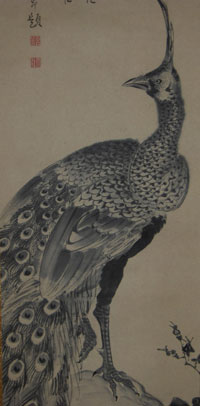Ichiryusai HIROSHIGE (1797-1858)
Click here to view image full size.
An important and rare original painting of a peacock ( Pavo cristatus ) perched on a rock with peony blossom ( Paeonia suffructiosa ). The regal peacock is usually shown with peonies, symbols of opulence and associated with summer. The subject and style borrows from the Chinese-derived Kano style, but with a spontaneous wet brush. The peony is the floral symbol of China and the peacock ( male peafowl ) was kept by the Chinese for centuries. It was a popular subject for Japanese artists of all schools and frequently used to demonstrate their dexterity, giving rise to often highly finished paintings. Hiroshige, as usual in his paintings, eschews this for a simpler approach. Hiroshige designed at least four prints of the same subject: An o-tanzaku published by Jakurindo, c. 1832; a chu-tanzaku with no publisher, c. 1832; a chu-tanzaku published by Marujin, c. early 1840s; and a kakemono-e published c. early 1840s. The style of signature on this painting dates it to c. 1832 – the best period for his kacho prints. Although I have had, and seen, a number of kacho hanshita-e, this is the first such painting I have catalogued. A Chinese-style poem top left. The painting is illustrated in the bicentennial exhibition of Hiroshige’s birth, The World of Hiroshige, 1996 – 1997, Mainichi Shimbunsha, no. 307; Ukiyo-e Painters and their Works, Volume 1, Yoshida Teruji, 1963, Ryokuen Shobo and was exhibited at the National Diet Library supervised by Dr Suzuki Shigezo, n.d. The inside of the box is guaranteed by Dr Narazaki Muneshige. Sumi on paper, mounted with box; image size 50 x 9.5 inches, 127 x 24 cms. Signed Hiroshige hitsu with Ichiryusai seal.
Status: Sold



